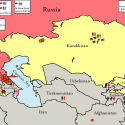 |
 |
Russia in Central Asia and the Caucasus

Key Takeaway: Russia took steps to expand and solidify its spheres of influence in Central Asia and the Caucasus to secure its dominance in the region while continuing to increase its military influence globally. Russia continues to project itself as an effective actor against terrorism in an effort to gain global legitimacy. It has positioned itself to play a larger role in anti-terrorist operations in Afghanistan, possibly in order to take advantage of the planned U.S. withdrawal by the end of January 2017. Russian President Vladimir Putin attempted to maintain control of the volatile North Caucasus region of Russia by appointing strongman Ramzan Kadyrov as leader of Chechnya until September 2016 as clashes between Russian security forces and anti-Russian militants continued. Russia also played a leading role in deescalating the conflict in the South Caucasus as two of its regional partners, Armenia and Azerbaijan, renewed hostilities over the long-disputed territory of Nagorno-Karabakh. Russia continues to arm both sides of the conflict, and its ally Armenia retains the ability to escalate the conflict. Russia’s partnership with Iran, which emerged primarily as a result of cooperation in support of the Assad regime in Syria, has intensified through efforts to expand bilateral cooperation in and around the Caspian Sea. Protests erupted across Russia’s primary regional partner Kazakhstan in response to new laws on land privatization, prompting the government of Kazakhstan to label the movements as an attempted coup and to crack down on dissent. Deadly clashes took place between unidentified militants and security officials in the western town of Aqtobe in Kazakhstan. Russia expressed confidence in Kazakh authorities’ ability to maintain control of the crisis and indicated that it would not get involved at the present time despite its high sensitivity to instability on its southern border and in its partner regimes.